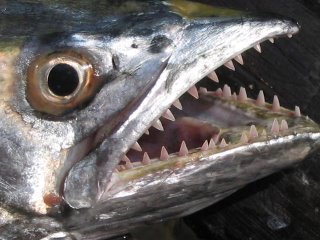Tropical Pacific Ocean Game Fish You Should Know

If you’re salt water fishing the Pacific Coast from Mexico, Central America to Ecuador, here are some species of game fish you’re likely to meet while trolling, long lining or jigging natural live baits in deep, warm waters near the coastline. The common names are listed above the scientific name.
Aguja (Needle fish or Dagger Fish)
Strongylura Scapularis
Aguja is a unique, green-boned predator that fights to the death. The long mouth is filled to the brim with rows of needle-sharp teeth and its slender, streamlined torso give it the name “Needles”. Seventy to one hundred cm in length and weighing up to 20 or more pounds, they can mate in as little as every 15 days. When they reach a meter or more in length, they can be quite dangerous to the inexperienced Aguja fisherman. I have the scars to prove it. They’ll go for a variety of live baits including flying fish or fresh cut bait on treble hooks and are abundant year-round. They’re best caught very early in the morning or at night near bait fish feeding grounds. Aguja is one of the most sought-after eating fish on the Pacific Coast. They’re absolutely delicious despite the strange-looking lime green bones.
Sierra, Common Sierra or Castilla
Scomberomorus Sierra
These fierce, voracious predators range from 20 to 40 cm in length and typically weigh from 6 to 8 pounds of lure-slamming, fighting fury. They’ll be more abundant during the months of June, July and August. Open waters near the coast or adjacent to coral formations are common hot spots these toothy targets that hit silver spoons with fish-catching regularity. Live bait of bait fish, squid or sardines work very well too. Their normal forage also includes shrimp and small crabs. Another of the most sought-after eating fish on the Pacific Coast.
Dorado (also known as Chimbila)
Coryphaena Hippurus
Most commonly caught in the length of 80 to 90 cm, weighing 12 to 15 pounds, they can measure one meter or more in length and weigh up to 30 pounds. They like tranquil waters near the surface and will hit top water plugs that imitate live bait fish. Extremely abundant during the months of December and January, they are often easily spotted feeding at or very near the surface. Watch for jumping, fleeing schools of panicked small fish. They’re normally loners, but can travel in small groups of up to eight fish. Their aerial acrobatics make them loads of fun to hook, but tricky to land.
Make a hookup with any of these denizens of the not-so-deep and I guarantee you won’t get bored. If you want to meet them all in a day or two, try some of their known “hangouts” near the Utria National Park waters at Ensenada off Colombia’s Pacific Coast. They’ll all be thereabouts from December through March. If you’d like to see some photos of members of this “Pacific Coast Posse”, e-mail the author at: lynchlarrym@gmail.com .
Good luck on your next fishing trip.


0 Comments:
Post a Comment
<< Home